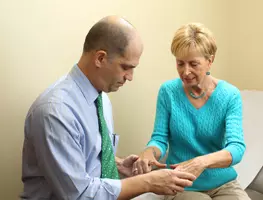- Home
- Patient Stories
- Merrily Madden - Osteoarthritis
Merrily Madden- Osteoarthritis
 Opposable thumbs provide humans with capabilities not enjoyed by most other animals, but when those thumbs don’t work, the limitations are dramatic. Witness Merrily Madden, who 12 years ago was suffering such pain in her thumbs that she couldn't open a jar, turn a doorknob, button a blouse or hold her dog’s leash.
Opposable thumbs provide humans with capabilities not enjoyed by most other animals, but when those thumbs don’t work, the limitations are dramatic. Witness Merrily Madden, who 12 years ago was suffering such pain in her thumbs that she couldn't open a jar, turn a doorknob, button a blouse or hold her dog’s leash.
According to Martin Boyer, MD, the Washington University orthopaedic surgeon at Barnes-Jewish Hospital who treated Merrily, the basal joint — where the thumb joins the hand — is a common location for osteoarthritis to strike, more so in women than in men for reasons not fully understood. Following the philosophy of providing conservative care first, Boyer, who is now the Carol B. and Jerome T. Loeb Professor of Orthopaedic Surgery and chief of the Hand & Wrist Service, prescribed anti-inflammatory drugs for Merrily, administered cortisone shots and even immobilized the joint with a splint to allow it time to heal. But during a year of treatment, none of those approaches worked satisfactorily.
Merrily, now 68 years old, had a full-time job at the time and was desirous of her previous high level of activity. So she and Boyer determined together to pursue surgery to correct her condition.
Arthritis of the basal joint attacks the smooth cartilage that covers the ends of the bones and allows fluid movement. When the cartilage is degraded, the result is bone-to-bone friction, grinding and pain. In fact, one of the diagnostic criteria is a sound like a hook-and-loop fastener separating when the joint is rotated.
To alleviate the condition, Boyer fully reconstructed the basal joint of Merrily’s hand by first removing the trapezium bone that supports the thumb and allows it to swivel and pivot. Then, harvesting a large tendon from the wrist and a smaller one from the forearm, Boyer crafted a sort of “hammock” for the thumb that located it in its proper place and prevented further bone-to-bone contact. A pin held the construction in place during healing. He operated on Merrily’s left hand in December of 1999 and corrected the condition in her right hand a year later.
Boyer says there are almost as many approaches to the operation as there are surgeons performing it, but that done correctly, it is a reliable solution with “great results,” for those disabled by pain. In the years he has performed the surgery for his patients, he has made a number of improvements to his own technique, but the results from even this early procedure have been faultless. Merrily says that’s not something all of her acquaintances who have had similar surgery elsewhere can say.
Merrily’s recovery involved five weeks in a full forearm cast followed by physical therapy with a hand therapist. She characterizes her care and the results as “excellent,” with no impairment of thumb motion, absolutely no ill effects from the tendon repurposing, and only minor scars from the incisions. For his part, Boyer says Merrily has been a “nearly perfect patient,” and the two have developed a close friendship over the decade they've been acquainted. Merrily’s gift on the occasion of Dr. Boyer’s marriage marks the depth of their relationship.
Merrily, who also contends with osteoarthritis in her neck and knees, remains aware of her thumbs’ vulnerability and guards their health carefully. But she now walks her rambunctious standard poodle on leash with confidence, and she recently celebrated her wedding anniversary with a trip to Branson, pain-free to applaud her favorite performers.
More Info: